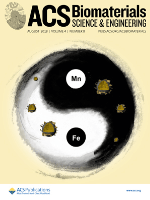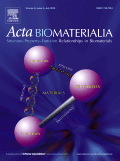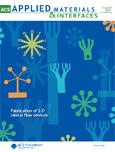
JOURNAL OF BIOMEDICAL MATERIALS RESEARCH PART A
Scope & Guideline
Innovating the intersection of materials science and medicine.
Introduction
Aims and Scopes
- Biomaterials Development:
Research on the design and synthesis of new biomaterials, including polymers, ceramics, and composites, tailored for specific medical applications. - Tissue Engineering:
Studies focused on creating biological substitutes that restore, maintain, or improve tissue function, utilizing scaffolds, hydrogels, and cell-based therapies. - Biocompatibility and Bioactivity:
Investigation into the interactions between biomaterials and biological systems, assessing their safety, effectiveness, and compatibility with human tissues. - Drug Delivery Systems:
Development of novel drug delivery platforms, including hydrogels and nanoparticles, for targeted and controlled release of therapeutic agents. - Regenerative Medicine:
Research aimed at understanding and utilizing biomaterials to promote tissue regeneration and healing, including strategies for stem cell therapies. - Nanotechnology in Biomaterials:
Exploration of nanomaterials and their applications in enhancing the properties and functionalities of biomaterials for biomedical use.
Trending and Emerging
- Smart Biomaterials:
Research on stimuli-responsive biomaterials that can change properties in response to environmental cues is on the rise, indicating a trend towards personalized and adaptive medical solutions. - 3D Printing and Bioprinting:
The use of additive manufacturing techniques for creating complex structures and scaffolds is increasingly popular, highlighting innovation in tissue engineering and regenerative medicine. - Sustainable and Bio-based Materials:
There is a growing interest in developing biomaterials from renewable resources, reflecting an emphasis on sustainability and environmental impact. - Cell-based Therapies:
Studies integrating biomaterials with stem cell technologies for regenerative applications are gaining momentum, underscoring the role of biomaterials in cell therapy. - Nanomedicine and Nanobiomaterials:
Research focusing on the application of nanotechnology in biomaterials, particularly for drug delivery and targeted therapy, is rapidly expanding. - Immunomodulatory Biomaterials:
The exploration of biomaterials that can modulate immune responses is becoming increasingly relevant, especially in the context of chronic inflammation and tissue regeneration.
Declining or Waning
- Traditional Biomaterials:
The focus on conventional biomaterials like simple polymers and metals is decreasing as newer, more complex materials and technologies gain prominence. - In vitro Models:
Research primarily using basic in vitro models for testing biomaterial interactions is becoming less common, with a shift towards more sophisticated in vivo and ex vivo models. - Static Testing Methods:
There is a waning interest in traditional static mechanical testing methods, with a growing demand for dynamic and physiologically relevant testing conditions. - Standardization of Biomaterials:
The emphasis on standardization protocols for biomaterials has diminished as researchers explore more innovative and application-specific approaches. - Long-term In Vivo Studies:
Longitudinal studies assessing the long-term performance of biomaterials in vivo are appearing less frequently, possibly due to the increasing complexity and cost of such studies.
Similar Journals

Materials Science & Engineering C-Materials for Biological Applications
Advancing biomaterials for a healthier future.Materials Science & Engineering C-Materials for Biological Applications is a premier journal published by ELSEVIER, dedicated to advancing the field of biomaterials through interdisciplinary research. With a robust ISSN of 0928-4931, this journal has made its mark in the realms of Chemical Engineering and Materials Science, achieving impressive Scopus rankings within its categories, namely Rank #16/151 in Bioengineering (89th percentile) and Rank #13/112 in Biomaterials (88th percentile). Although the journal's coverage in Scopus has been discontinued since 2021, it remains a critical resource for researchers, professionals, and students eager to explore innovative materials and their applications in biological contexts. The journal’s open access policy enhances its accessibility, fostering a global exchange of knowledge and inspiring future advancements in the field of materials science.

Frontiers in Bioengineering and Biotechnology
Catalyzing Change through Cutting-Edge ResearchFrontiers in Bioengineering and Biotechnology, published by FRONTIERS MEDIA SA in Switzerland, stands as a leading platform for innovative research and developments in the fields of bioengineering and biotechnology. Since its inception in 2013, this Open Access journal has garnered significant recognition, reflected in its impressive category rankings: Q1 in Biomedical Engineering and Q2 in Bioengineering, Biotechnology, and Histology for 2023. With a focus on fostering collaboration and knowledge sharing, it aims to provide researchers, professionals, and students with access to pioneering studies that push the boundaries of science and technology. The journal, which is indexed in prominent databases, boasts high visibility and impact, evidenced by its impressive rankings across various categories in Scopus. As it continues to converge from 2013 to 2024, Frontiers in Bioengineering and Biotechnology is dedicated to shaping the discourse in its field and promoting advancements that have the potential to transform healthcare and environmental sustainability.

Biomedical Materials
Empowering Research in Biomaterials and Bioengineering.Biomedical Materials, published by IOP Publishing Ltd, is a premier journal dedicated to the rapidly evolving field of biomedical engineering and materials science. With a robust impact factor showcasing its influence, this journal serves as a vital platform for disseminating pioneering research from 2006 to 2024. Covering an array of interdisciplinary topics—ranging from biomaterials to bioengineering and applied chemistry—the journal consistently ranks in the second quartile across multiple categories including Bioengineering (Q2), Biomaterials (Q2), and Biomedical Engineering (Q2) as of 2023. Researchers, professionals, and students alike benefit from its contributions, exploring innovative solutions at the intersection of biology and material science. Although not an Open Access journal, Biomedical Materials remains essential in advancing our understanding and facilitating discussions surrounding state-of-the-art materials that revolutionize medical applications and enhance patient care.

ACS Biomaterials Science & Engineering
Innovating the Intersection of Science and MedicineACS Biomaterials Science & Engineering, published by the American Chemical Society, serves as a premier platform for the latest advancements and research in the fields of biomaterials and biomedical engineering. With an impressive impact factor and a strong reputation reflected in its ranking—Q2 in Biomaterials and Q1 in Biomedical Engineering—the journal attracts a diverse and engaged readership. Since its inception in 2015, it has aimed to foster innovation by publishing high-quality research articles, reviews, and perspectives on the synthesis, characterization, and application of biomaterials. Researchers and professionals benefit from the journal's rigorous peer-review process and its focus on translational science, making it essential for those looking to stay at the forefront of biomaterials research. Located in Washington, DC, USA, the journal plays a pivotal role in connecting academic and industrial sectors, ultimately driving advancements that impact biomedicine and related fields.

Acta Biomaterialia
Innovating at the Intersection of Biology and EngineeringActa Biomaterialia, published by Elsevier Science Ltd, is a leading journal in the fields of biochemistry, biomaterials, biomedical engineering, biotechnology, and molecular biology. With an ISSN of 1742-7061 and an E-ISSN of 1878-7568, this prestigious journal has secured a remarkable position in the academic community, evidenced by its inclusion in the Q1 category across multiple disciplines for 2023. It ranks impressively at #21 in biochemistry, #16 in biomedical engineering, #18 in biotechnology, and #11 in biomaterials, reflecting its high impact and relevance to ongoing research and development. The journal provides a platform for disseminating innovative research and advancements in the design and application of biomaterials, contributing to scientific discussions that propel the field forward. Although it does not currently offer open access options, Acta Biomaterialia continues to attract contributions that advance our understanding of biomaterials and their interactions with biological systems, ensuring that researchers, professionals, and students remain informed about the latest trends and breakthroughs in this rapidly evolving area of study.

Biomaterials Advances
Unleashing Potential: The Next Wave of Biomaterials InnovationBiomaterials Advances is a premier journal published by Elsevier, dedicated to the rapidly evolving field of biomaterials. Established in the United Kingdom, this open-access journal aims to disseminate high-quality, peer-reviewed research that explores innovative biomaterial designs and their applications in bioengineering and biomedical engineering. With an impressive 2023 impact factor reflected in its Q1 rankings across multiple categories—including Bioengineering, Biomaterials, and Biomedical Engineering—Biomaterials Advances stands out as a critical platform for scholars and practitioners faced with advancing technologies and methodologies in the realm of materials science. Covering a broad range of topics, from biocompatibility to tissue engineering, this journal provides an inclusive forum for researchers seeking to contribute to the field. Its Scopus rankings further affirm its position as a leading resource, with notable standings in Biomedical Engineering (Rank #13), Biomaterials (Rank #8), and Bioengineering (Rank #11), all within the top percentiles. Researchers and students alike are encouraged to contribute and engage with the latest findings and innovations in biomaterials through this valuable publication.

VIEW
Uniting Global Scholars in Biomedical Engineering Advancement.VIEW is a prestigious journal published by WILEY that focuses on the rapidly evolving fields of Biomaterials and Biomedical Engineering. Since its inception in 2020, VIEW has established itself as an open-access platform dedicated to disseminating high-quality research and innovation within these disciplines. With an impressive impact factor that places it in the Q1 category of both Biomaterials and Biomedical Engineering, VIEW ranks among the top journals in its field, boasting a 91st percentile ranking in Biomedical Engineering and an 85th percentile ranking in Materials Science. Researchers, professionals, and students are encouraged to utilize this invaluable resource, as it provides a comprehensive view of current advancements and future trends in biomaterial science and engineering. Positioned in the United Kingdom, VIEW operates as a vital scholarly communication link, fostering collaboration and knowledge sharing within an ever-growing global community.

International Journal of Biomaterials
Fostering collaboration for breakthrough advancements in biomaterials.The International Journal of Biomaterials, published by HINDAWI LTD, is a premier platform for disseminating groundbreaking research in the fields of biomaterials and biomedical engineering. With an Open Access approach since 2009, this journal provides unhindered access to innovative studies and applications aimed at advancing medical technologies and improving patient outcomes. Notably ranked in the Q3 category for both Biomaterials and Biomedical Engineering in 2023, it serves as an essential resource for researchers, practitioners, and students alike. The journal's Scopus rankings, including a 49th percentile in Biomedical Engineering and a 40th percentile in Biomaterials, further underscore its growing prominence in the academic community. With contributions spanning from 2011 to 2024, the journal seeks to foster collaborative research and promote developments that enhance the understanding and application of biomaterials in healthcare.

Advanced Biomedical Engineering
Unleashing potential through open access research.Advanced Biomedical Engineering is a peer-reviewed open access journal published by the Japanese Society for Medical & Biological Engineering, dedicated to disseminating high-quality research in the multidisciplinary fields of biomedical engineering. Boasting an ISSN of 2187-5219, this journal has been pivotal since its inception in 2018, especially as it embraces the open access model to foster knowledge sharing and wide accessibility. Centered in Tokyo, Japan, it serves as a vital platform for scholars and practitioners across various domains, such as biomaterials, biomedical engineering, and biotechnology. Despite currently residing in the Q4 quartile across several categories, including those in biotechnology and computer science applications, the journal is committed to elevating its academic impact and reputation, aiming for improved rankings in Scopus and other databases. Researchers and professionals are encouraged to contribute their innovative findings, discussions, and case studies, facilitating the advancement of this dynamic field.

ACS Applied Materials & Interfaces
Transforming Research into Real-World ApplicationsACS Applied Materials & Interfaces, published by the American Chemical Society, stands as a leading journal in the field of applied materials, nanotechnology, and interdisciplinary research in medicine. With an impressive Impact Factor that places it in the Q1 category across Materials Science, Medicine, and Nanoscience and Nanotechnology, this journal consistently ranks among the top tier, evidencing its significance and influence in advancing scientific knowledge. The journal’s scopus ranking of 33 out of 463 in General Materials Science further underscores its critical role in disseminating innovative and high-quality research. Although it is not an open-access journal, a diverse range of access options is available, ensuring that vital research findings are accessible to a broad audience of researchers, professionals, and students. Targeting breakthroughs in the synthesis, characterization, and application of materials and interfaces, ACS Applied Materials & Interfaces serves as a pivotal platform for publishing cutting-edge studies essential for future technological advancements.